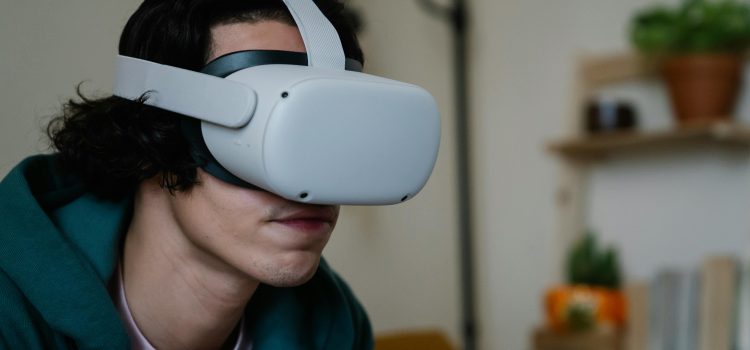
The Growth of AR and VR Products in 2024
The year 2024 is shaping up to be a pivotal one for the augmented reality (AR) and virtual reality (VR) markets. The rapid advancements in technology, coupled with increased consumer and enterprise adoption, are propelling AR and VR products into the mainstream. This article delves into the growth trajectory of AR and VR products, the driving factors behind this surge, and the future outlook for these transformative technologies.

The Evolution of AR and VR Products
Augmented reality and virtual reality have been in development for decades, but it is only in recent years that they have begun to realize their full potential. AR overlays digital information onto the physical world, enhancing real-world experiences with interactive elements. In contrast, VR immerses users in a completely virtual environment, often through the use of headsets and motion-tracking devices.
In 2024, AR and VR products have evolved significantly from their early iterations. The hardware has become more sophisticated, with lighter, more comfortable headsets, higher resolution displays, and improved motion tracking. Additionally, software advancements have led to more immersive and interactive experiences, making these technologies more appealing to a broader audience.
Market Growth and Adoption
The AR and VR markets are experiencing unprecedented growth. According to industry reports, the global AR and VR market is expected to reach $209.2 billion by 2024, up from $37.0 billion in 2021. This growth is driven by several factors:
Consumer Adoption
One of the primary drivers of the growth in AR and VR products is increased consumer adoption. Gaming remains a significant market for VR, with popular titles like “Half-Life: Alyx” and “Beat Saber” showcasing the potential of immersive gameplay. In 2024, the gaming industry continues to be a stronghold for VR, with more AAA titles and indie games embracing the technology.
AR, on the other hand, has found a niche in mobile applications. Apps like Pokémon GO and Snapchat have introduced millions of users to AR, and the technology is now being integrated into various aspects of daily life, from navigation to shopping. The introduction of AR glasses, such as those from Apple and Google, is expected to further drive consumer adoption by providing hands-free, immersive experiences.
Enterprise Applications
Beyond consumer use, AR and VR products are making significant inroads into enterprise applications. Companies across various industries are leveraging these technologies to enhance productivity, training, and customer engagement.
In the healthcare sector, VR is being used for medical training, allowing students and professionals to practice procedures in a risk-free environment. AR is being employed in surgery, providing real-time overlays of critical information to surgeons.
The manufacturing and automotive industries are also benefiting from AR and VR. These technologies are being used for design and prototyping, reducing the time and cost associated with traditional methods. Workers are using AR glasses for hands-free access to information and instructions, improving efficiency and safety.
Education and Training
AR and VR products are revolutionizing education and training. Virtual classrooms and training simulations provide immersive learning experiences that are more engaging and effective than traditional methods. In 2024, more educational institutions and corporate training programs are incorporating AR and VR to enhance learning outcomes.
For example, VR simulations allow students to explore historical sites, conduct virtual science experiments, and even practice public speaking in a simulated environment. AR, on the other hand, is being used to create interactive textbooks and educational apps that bring learning materials to life.
Technological Advancements
The growth of AR and VR products in 2024 can be attributed to several key technological advancements:
Improved Hardware
The hardware for AR and VR has seen significant improvements. Modern VR headsets offer higher resolution displays, wider fields of view, and better motion tracking. This results in more immersive and comfortable experiences for users. AR glasses have become lighter and more stylish, making them more practical for everyday use.
5G Connectivity
The rollout of 5G networks is another critical factor driving the growth of AR and VR products. The increased bandwidth and lower latency of 5G networks enable more seamless and responsive experiences. This is particularly important for AR applications that rely on real-time data overlays and for VR experiences that require high-quality streaming.
Advanced Software and AI
Advancements in software and artificial intelligence (AI) are enhancing the capabilities of AR and VR products. AI algorithms are being used to improve object recognition and tracking in AR applications, making interactions more intuitive and accurate. In VR, AI is being used to create more realistic and dynamic virtual environments.
Cloud Computing
Cloud computing is also playing a significant role in the growth of AR and VR. Cloud-based platforms allow for the offloading of processing tasks, enabling more complex and resource-intensive applications to run on less powerful devices. This is particularly beneficial for mobile AR applications and standalone VR headsets.
Challenges and Future Outlook
While the growth of AR and VR products in 2024 is impressive, there are still challenges to overcome. One of the primary challenges is the cost of hardware. High-quality AR and VR devices can be expensive, limiting their accessibility to a broader audience. However, as technology advances and economies of scale come into play, prices are expected to decrease.
Another challenge is the development of content. Creating high-quality AR and VR experiences requires specialized skills and significant investment. However, as more tools and platforms become available, the barrier to entry for content creation is expected to lower, leading to a more diverse range of applications and experiences.
Looking ahead, the future of AR and VR products is bright. The technologies are expected to become more integrated into our daily lives, transforming how we work, learn, and play. The convergence of AR and VR with other emerging technologies, such as artificial intelligence, the Internet of Things (IoT), and blockchain, will unlock new possibilities and use cases.
Conclusion
a landmark year for the growth of AR and VR products. . The advancements in hardware, software, and connectivity, coupled with increased consumer and enterprise adoption, are driving these technologies into the mainstream. As AR and VR continue to evolve, they have the potential to revolutionize various aspects of our lives, offering new ways to interact with the world around us.










